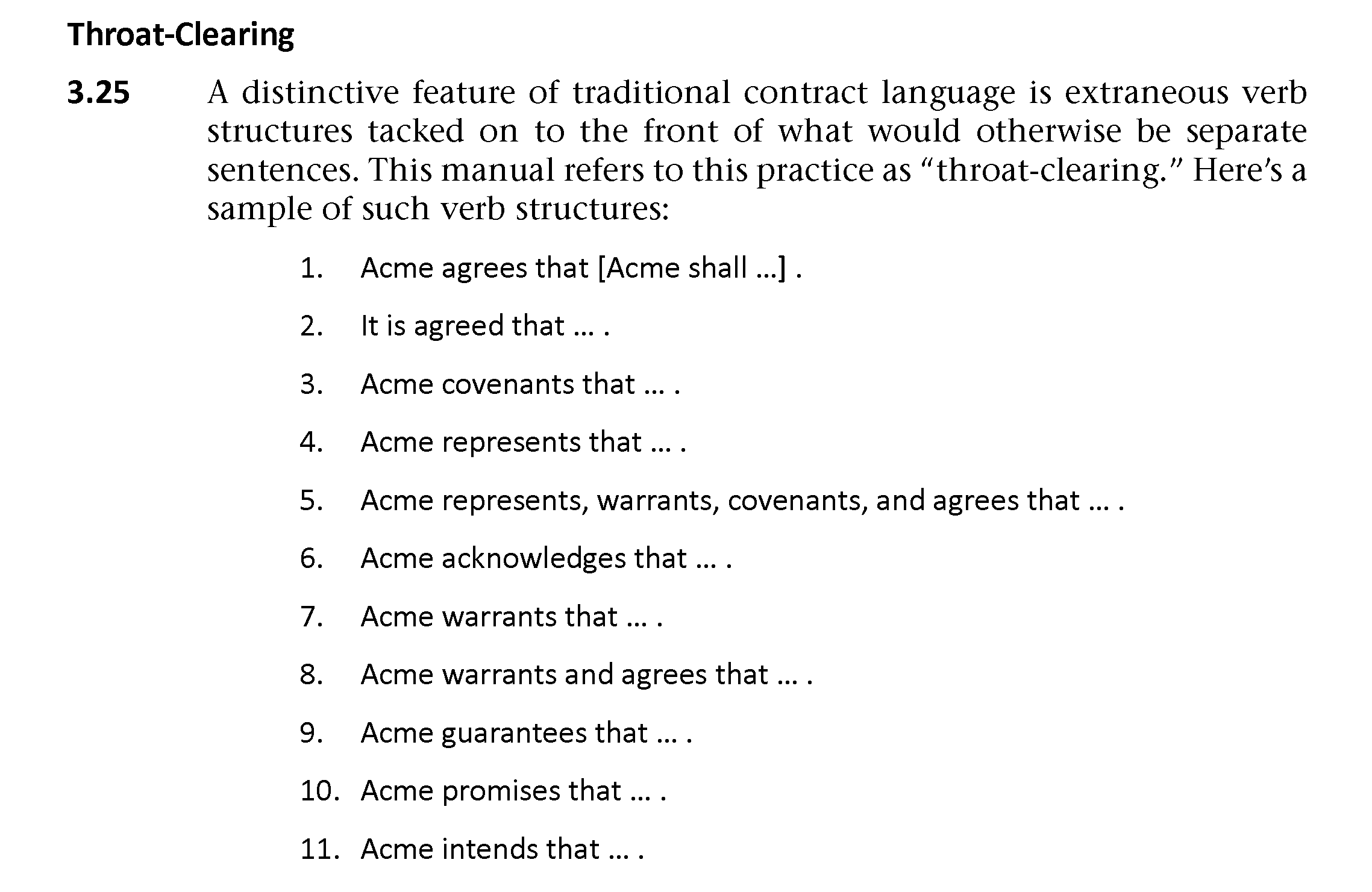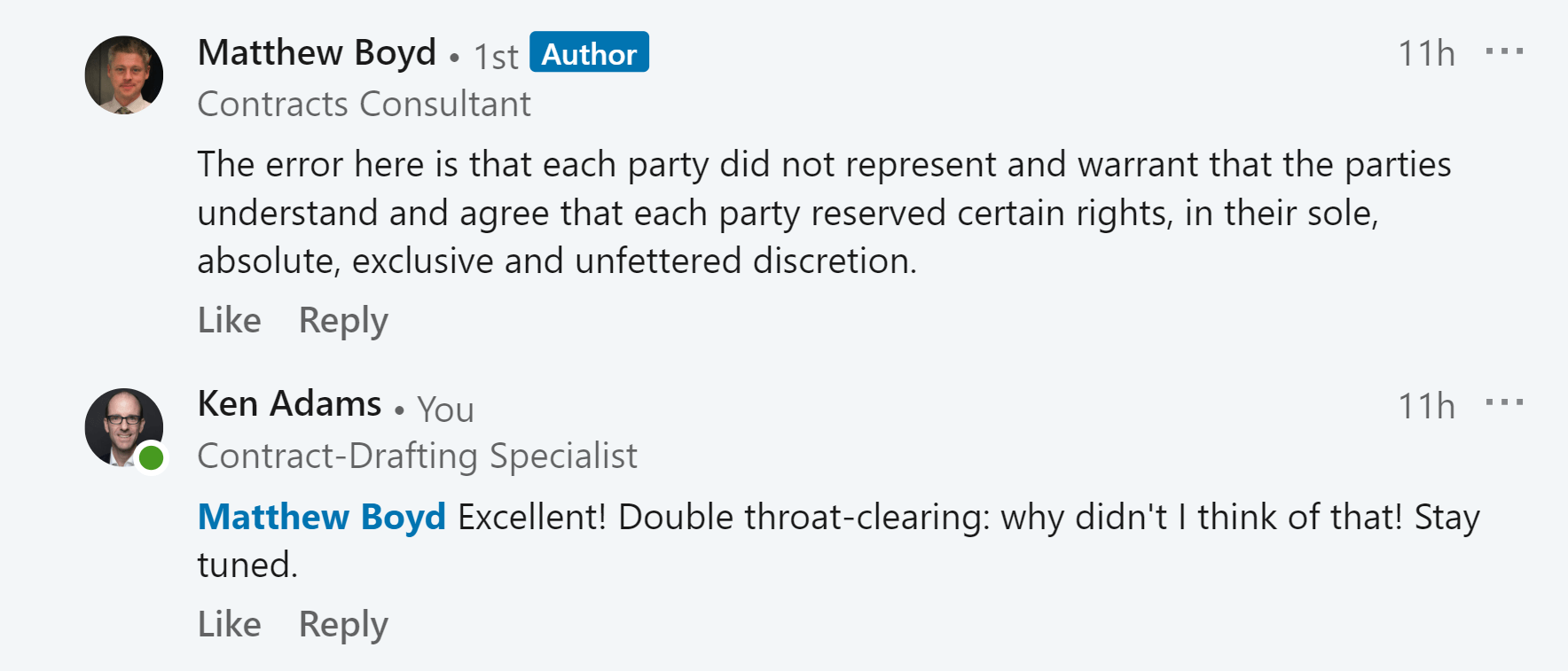One of my favorite categories-of-contract-language topics is what I call “throat clearing.” That’s when you have an extraneous verb structure bolted to the front end of a sentence.
I haven’t discussed throat-clearing much on this blog, so here’s the first section of MSCD‘s treatment of the subject:
I mention this because of an exchange I had today with Matt Boyd on the LinkedIn group A Manual of Style for Contract Drafting. Here’s the pertinent extract:
Of course, I turned to EDGAR and found what I was looking for:
The Lead Manager hereby agrees that it undertakes that it shall: (i) submit a photocopy of this Agreement being executed by all the parties hereto …
It is further agreed that the insurer undertakes that it shall not contend that a wrongful act was committed recklessly by any insured unless it can be proven that …
So double throat-clearing exists! Two redundant verb structures stuck at the front of a sentence! In the first example, The Lead Manager shall is all that’s required; in the second example, The insurer shall not. But I don’t expect to start seeing double throat-clearing all over the place.
I draw no profound conclusions from all this, except that I’m reminded yet again that traditional contract language is profoundly weird.



And then there are those old warhorses “for the avoidance of doubt” and “without limiting the generality of the foregoing.” What’s unusual, I guess, about FAOD is that it’s not a verb phrase.
They’re perhaps prompted by the same urge, but they’re unrelated to throat-clearing, at least in the technical sense that I use the term. More broadly, half of traditional contract drafting could be described as throat-clearing.
I believe your last sentence touches on the greatest obstacle to the improvement of contract drafting: It isn’t that lawyers don’t have a reliable guide to follow (thanks to the MSCD), rather the problem is that too many lawyers can’t properly evaluate the quality of their own drafting because they haven’t learned how to write well. That admitting as much would be professional suicide seems like the second major obstacle.
Both of those are due to old canons of legal construction which are used less aggressively these days.
It used to be a very strong rule that if something could be interpreted as limiting the generality of a previous clause, it WOULD be. And if something appeared redundant, it would be interpreted as non-redundant, even if it required twisting into pretzels to do so. (Thus requiring “for the avoidance of doubt” for things which are actually redundant but presented for clarity.) These rules are both still in the canons of construction, but it’s generally applied less harshly than it was in, say, the 1700s.
Here’s an argument that the second example from the manure lagoon is *triple* throat clearing: ‘Acme shall not contend that X is so’ has a needless verb structure at the front. The thought could be expressed directly as ‘X is not so for purposes of this contract unless the following condition is met’.
A less abstract example would be to recast that second example in this way: ‘No act by the insured will constitute a wrongful or reckless act under this agreement unless….’
This next is off point, but the condition of a reckless wrong in the same example is odd: no reckless wrong exists unless ‘it can be proven that X’.
The condition as stated is not that ‘a competent tribunal *finds* X’ or even that ‘X *has been* proven’ (past tense), but merely that ‘X *can be* proven’. By whom? Where? When? To whose satisfaction?
Not throat clearing, just failure to think the matter through, leaving it ripe for dispute.
Well, it is cold and flu season.
I suppose this comes from ancient days when a bunch of different contracts and things which weren’t contracts might be on the same piece of paper. (Consider that a “statute” was every single thing the Parliament did in one months-long SESSION back in Medieval England.)
So the opening agreement clause saying “this is agreed between A and B” might well be repeated every paragraph, or for every sentence which was part of the contract, just to make it clear that this wasn’t part of the contract between C and D or part of the affadavit from E, which were all on the same piece of paper.
So there’s your historical explanation. The concept that a contract would have its own isolated piece of paper is relatively new, and the introductory “contract clauses” are to tell you which parts of the writing are actually part of the contract and which aren’t.
You can still see this sort of stuff in informal employment letters, which can contain all sorts of non-contract stuff (“I’m interested to hear about your knitting hobby”) and a contract hidden in there somewhere…